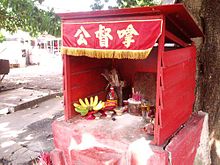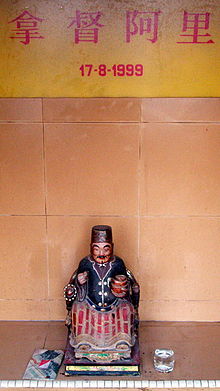- Na Tuk Kong
-
Na Tuk Kong (Chinese: 拿督公; pinyin: Ná Dū Gōng; Pe̍h-ōe-jī: Ná-tok-kong) are local guardian spirits in Malaysia. One derivation of the name unites Dato or Datuk from the local Malay word for 'grandfather', which is used as an honorific, combined with Kong from the Malaysian Chinese, also used as an honorific. Another derivation of Na Tuk Kong is that they belong to the gods of Teh Choo Kong (Tu Di Kong) which originated from China.
Contents
Origins
Asian religions is nature worship. Na Tuks could be remnants of pre-Islamic Malay religion. In Malay, pagan spirits are usually called jin kafir while guardian spirits are called penunggu. Penunggu usually means watchman, guard or attendant.
Datos and Keramats were seen as an alternative power to help in spiritual healing and grant protection. Mediums (bomoh) were engaged to enable communication between worshippers with the Datos and Keramats. The Datos and Keramats include spirits residing in trees, stones and even the spirits of well known local Muslim religious teachers (worshipped at their graves).
The worship of Datos among Malays and Indian Muslims declined steadily after Islamic authorities started clamping down on such activities. By that time, Dato worship have taken root in the local Chinese spiritual beliefs.
It is not clear why the Chinese, having their own Earth deity can easily accept the Dato into their religious pantheon. May be they need a local deity to gain more spiritual protection. Datos are known to grant winning numbers to worshippers. That could be one reason Datos were absorbed into the Malaysian Chinese religious pantheon.
Malaysian Chinese's definition
To most Malaysian Chinese, the Na Tuk Kong (Hokkien : Da Tok Kong) is a local guardian spirit that resides in trees, ant hills, caves, riversides and in strange stone formations. A Na Tuk Kong worship usually begin after a person is granted vision of the Na Tok's spiritual form. Some common forms are a white tiger and the form of an old man dressed in white. A Na Tuk Kong can also be 'invited' to reside outside (never indoors) a family home for spiritual protection and luck. Some people build small shrines by the road for this deity.
Variants
 Photo of Malay-Chinese deity Datuk Samsuri, the shrine is at Cheras of Kuala Lumpur.
Photo of Malay-Chinese deity Datuk Samsuri, the shrine is at Cheras of Kuala Lumpur.
There is one fierce guardian of villages called the Dato' Panglima Hitam. A Dato that resides in trees is called Dato' Hijau. Some Datos even have their own personal names, which are revealed to worshippers during trance session. Their identity can be ascertained by looking at the banner at the shrine. Usually, the Dato's name and the shrine's date of establishment would be stated there.
Worship
The Na Tuk can be worshipped on any day. The basic offerings are a pair of white candles, 3 joss sticks and burning gum Benjamin (kemanyan). Na Tuk worshippers prepare special offerings for the Na Tuk on Thursday evenings. A set of betel nut leaves complete with lime (kapur), sliced betel nut (pinang), Javanese tobacco (tembakau Jawa) and palm cigarette leaves (rokok daun) are offered together with fruits and the basic offerings.
Every Na Tuk has different individual feast days. In the Northern States (Perlis, Kedah & Penang), worshippers usually slaughter chickens, and sometimes goats to honour the Na Tuk on the feast day. The chickens and cows must be slaughtered by a Muslim. Especially goats so as to make the offering allowable for the Na Tuk. The meat is later cooked in curry and offered to the Na Tuk together with turmeric rice(nasi kunyit). This offering is also done when worshippers get their wishes granted (e.g. winning lucky numbers requested from the Na Tuk previously).
Offerings
Worshippers can place offerings of shredded tobacco, areca nut flakes, betel leaves with lime paste and fruits. Pork, beer, wine and alcoholic products are not used in offerings, as they are in conflict with Islamic rules.
Panglima Ah Chong
One Na Tuk Kong was originally a man of Cantonese Hakka family, his name was So Ah Chong (苏亚松). He was the leader of Ghee Hin secret society that founded more than 16 tin mine settlements. The municipal government of Taiping named a road after him for his contribution in the economy. In June 1865 he was captured and sentenced to death by local Malay chief of Matang during the Larut War among secret societies, and the Malay chief honored him by calling him Panglima Ah Chong (Commander Ah Chong). After his heroic death, it was said the godship of him was very effective for his worshippers and so peoples of Matang and coastal dwellers built shrines to worship him.
Dato Haji Keramat
The local Malay word 'Datuk Keramat' means deity of the shrine, translated to Chinese is Na Tuk Kong, where Kong is a respect. Dato Haji Keramat is a very powerful local earth deity that help many people who sincerely pray for him. He hates a lot about alcohol. There are various Na Tuk Kongs. In Chinese Taoist System, Na Tuk Kongs official title called 拿督尊王。
Datuk Zhang
In the Ming chronicle, during the reign of emperor Wan Li 1573-1620 (万历皇帝), a man known as Zhang who lived in Brunei, originally from Zhangzhou of Fujian province, was appointed 'Datuk' of (Brunei). For certain injustice reason Datuk Zhang committed suicide, and so his countrymen wanted justice for him.
See also
- Malaysian Chinese Gods
- Chinese Malaysian
- Chinese religion
- Ancestor worship
- Superstition of Malaysian Chinese
- Fengshui
- Chinese folk religion
- Chinese mythology
- list of deities
References
- The Encyclopedia of Malaysia, vol. Religions & Beliefs, edited by Prof. Dr M. Kamal Hassan & Dr. Ghazali bin Basri ISBN 981-3018-51-8 [1]
External links
Categories:- Religion in Malaysia
- Malaysian mythology
- Chinese gods
Wikimedia Foundation. 2010.



